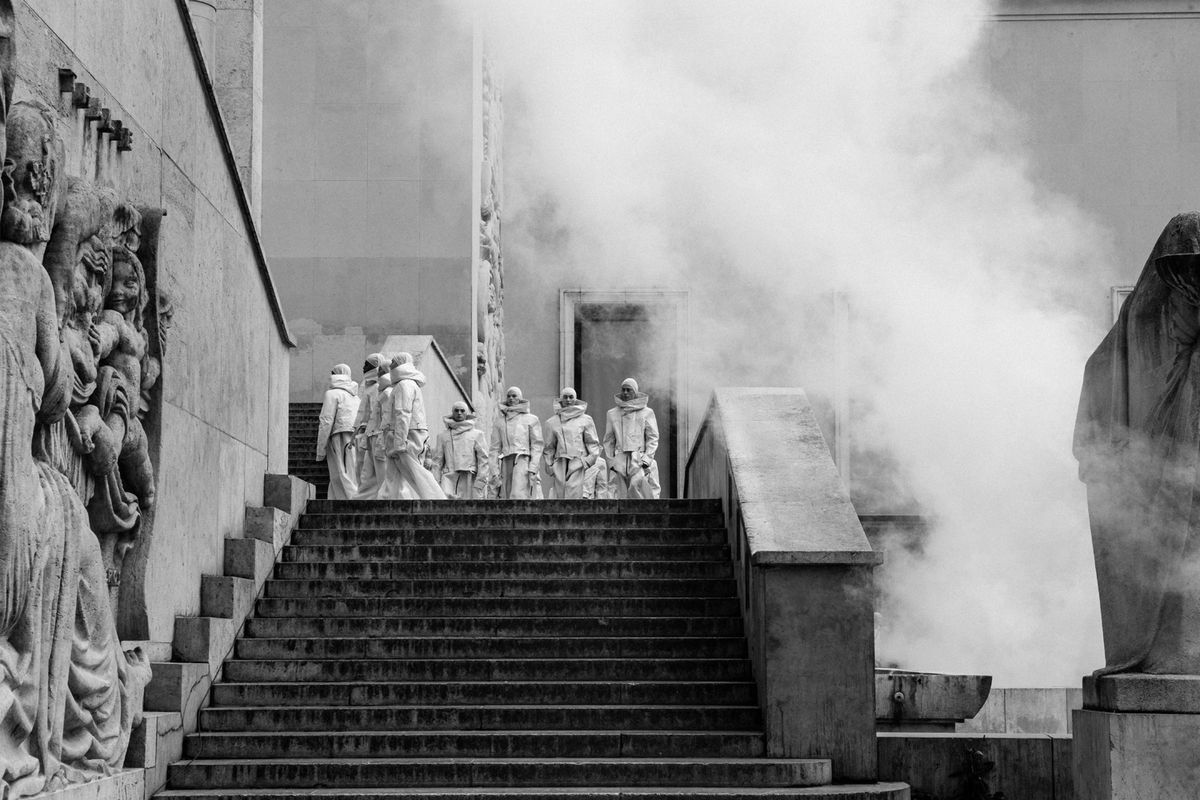Travel
You’ve Got 12 Summer Weekends. We’ve Got a Perfect Trip for Each One.
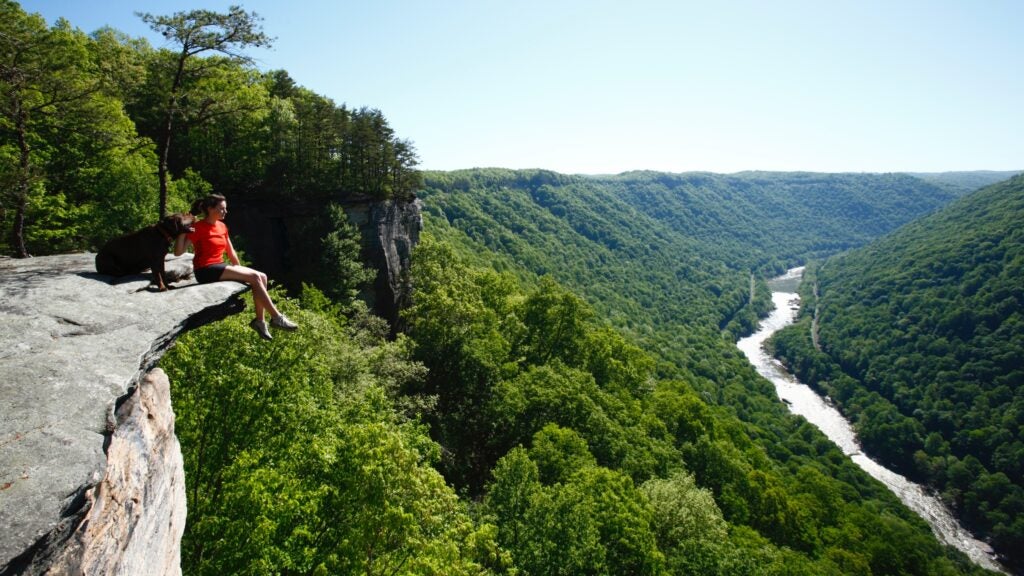
This is the eternal paradox of summer: the days are longer and yet they always seem to fly by faster. But there is a way to make the most of the season before the solstice even arrives: plan now to lock in your summer of endless adventure.
To help you strategize, I put together a foolproof calendar for summer 2024, highlighting the best places to go each weekend this summer. I’ve been to many of them, and have plans to visit the rest as soon as I can. Consider this a guide to your best summer yet.
Where to Go in June
June 13-16: New River Gorge, West Virginia
There are few better ways to kick off summer than by communing with like-minded revelerss at the four-day Waynestock Outdoor Adventure and Music Festival, held just outside Fayetteville. A mashup of a backyard alt-band concert with outdoor sports, the event is celebrating its 25th anniversary this year with musical acts that include Pittsburgh rock band The Roof, indie-rocker Kyle Sparkman, and Americana band Widely Grown. That’s at night.
During the day, the festival organizes an impressive array of activities for attendees, from mountain biking to rock climbing to traversing the catwalk on the underside of the 851-foot-high New River Gorge Bridge. And this is whitewater country, so your to-do list should include a rafting trip down the New River, which, despite its name, is one of the oldest rivers in North America and part of the namesake national park nearby. The view of the gorge from water level is one of the more impressive in the East, and the Class II–III rapids are a perfect way to get refreshed for another evening of live performances.
Where to Stay: The festival’s general-admission package, which includes a three-day camping permit, costs $155. You really will get the most out of the event by staying on-site. Prefer to sleep in a bed? Upgrade to a premium tent at the festival’s fully furnished Pop-Up BNB Glamping Rentals (from $650 for three nights).
Don’t Miss: Fayetteville, a small-town gem with shops, art galleries, and restaurants. For regional mementos—morel mushroom key chains, dragonfly crop tops, opossum screen prints—check out Lost Appalachia Trading Co. For a hot meal to satisfy any post-camping cravings, Wanderlust Creativefoods serves comfort food from around the world, a welcome surprise in rural West Virginia.
June 22-23: Gunnison Gorge National Conservation Area, Colorado
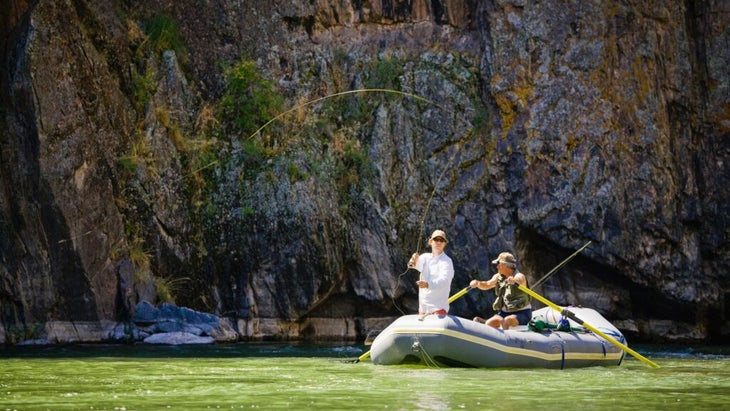
Every June, obsessive fly-fishers like me fret over which weekend is going to be the one—when salmonfly nymphs swim to the surface of the Gunnison River and metamorphose into prehistoric-looking, palm-size bugs, sending wild trout into a frenzy. The hatch is legendary among Western Slope anglers, and it usually lasts for a week or two at most. Time it perfectly and you can catch boatloads of fish. When I worked as an editor for Outside and lived in Santa Fe, my colleagues and I would obsess about when exactly to pull the trigger and head north for a three-day float, hoping to have a 20-fish-over-20-inch day, something that’s only possible on a river like the Gunnison.
This season, thanks to an above-average amount of snowpack, mid-June is a good bet for a successful trip (although warmer temperatures could make the hatch happen earlier; check with the guides at Pleasure Park). Regardless, fishing this river in July is a joy, and running the Class III–IV rapids through the sheer-walled Black Canyon—Colorado’s version of the Grand Canyon—only adds to the adventure.
Where to Stay: If you’re going through the hassle of shuttling a boat a mile down the Chukar Trail for the 14-mile float to Pleasure Park, camp two nights along the river, the maximum you’re allowed to stay in the canyon, which is managed by the BLM. (Day-use fees are $3 per person; camping costs $15 for two nights.) Before setting off, arrange a shuttle to get your vehicle back to the takeout through the Pleasure Park. If you’re traveling with a crew and multiple boats, it’s best to opt for the services of J and Ray Outfitters, whose horses will pack your gear down to the river from the top of Chukar Trail. It’s more than worth the $125 per horse.
Don’t Miss: The enjoyment that comes with savoring things really slowly. Many people do this float in a single day, and that’s a shame. Take the time to pull over frequently and fish from shore. Better yet, set up your camp early, have a cocktail hour and dinner, and then head out for some evening casting. Reeling in a wild rainbow trout in the Black Canyon’s sunlight afterglow may be the closest thing to bliss an angler will get.
June 29-30: Glacier National Park, Montana
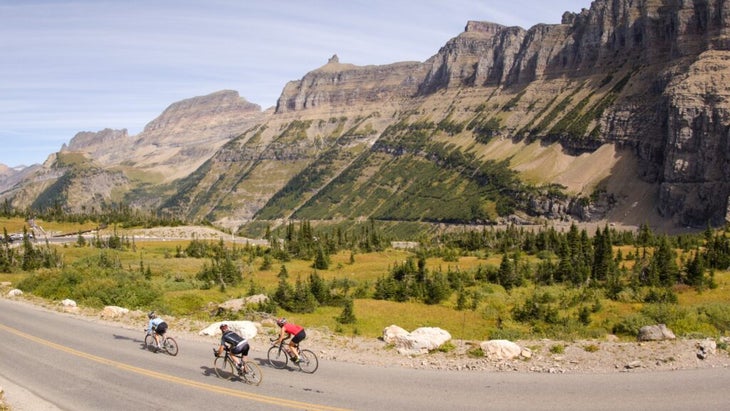
Each summer before the park’s iconic Going-to-the-Sun Road fully opens to vehicles (typically in mid-to-late June), cyclists and hikers have a chance to explore all 50 miles of its majestic mountainscapes and glacial valleys traffic-free. Snowplows are working now to clear the higher alpine sections of the road en route to 6,646-foot Logan Pass, right on the Continental Divide, where drifts were a reported 80 feet high at the end of May.
How long will you be able to cruise down on your bike in peace? Keep an eye on the Park Service’s interactive map, which tracks road conditions and openings, or call ahead for the lowdown (406-888-7800). Weather has been warming quickly, so it could be an early opening for auto traffic and you could miss your window.
Where to Stay: Lake McDonald Lodge, a chalet located ten miles from Glacier’s West Entrance, perfectly exemplifies Parkitecture, the name given to the grand resorts built with whole logs and interiors straight out of a Filson catalog (rooms from $206 or upwards of $500 on weekends). You can also sleep under the stars at Under Canvas; the glamping outfitter has a camp just seven miles outside the West Entrance (from $179).
Don’t Miss: Follow the dusty North Fork Road from West Glacier up to the town of Polebridge—it’s an hour’s drive but worth it for the pastries of Polebridge Mercantile, which churns out huckleberry bear claws, cookies, and other freshly baked temptations in the summer. I’ve been to it twice, roughly 20 years apart, and the second visit lived up to all those years of unrealistic expectations. Those flaky, buttery bear claws are second to none. Sure, my love for this place may have to do with the remote setting and dramatic views of the Livingston Range, but I’ve never stopped dreaming of returning.
Where to Go in July
July 6-7: Key West, Florida
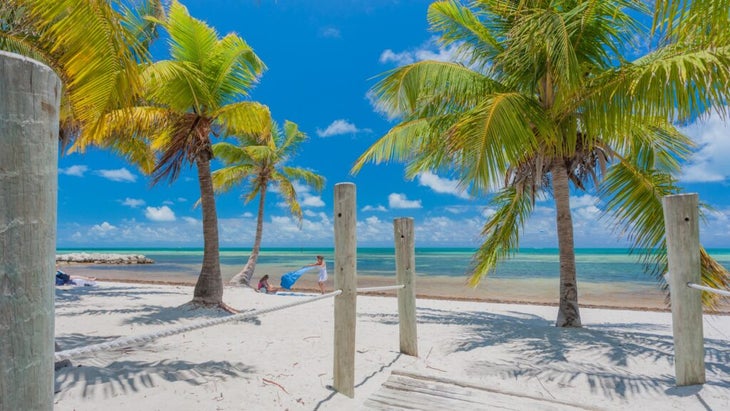
Southern Florida may seem like a questionable destination for a midsummer getaway, but if you’re a local, you know that July is the best month here: there are far fewer tourists, cruise-ship arrivals wane, and residents turn out for events like the Key Lime Festival (this year from July 4 to 7), which honors the tiny citrus fruit.
Worried about the heat? Don’t be. Thanks to prevailing winds coming off the ocean, Key West has never notched a temperature above 97 degrees. Summer is hot and sticky, sure, but less so than many other places in the South. Also, saltwater fly-fishers would wager July to be the best month for a grand slam—landing a permit, a bonefish, and a tarpon all in the same day—on the flats. Because the water is calm, you sight-cast to big fish patrolling the shallows, an adrenaline rush like few others.
Where to Stay: One of the great charms of Key West is its walkability. There’s no reason to get in a car. Book a place with access to Duval Street, the main thoroughfare, but a block or two away to ensure the noise isn’t overwhelming. There are a couple of great hotels, including the Mansion on the Sea (from $499), but many Airbnb rentals have private pools and may prove better value for your buck, especially if you’re traveling with family or friends.
Don’t Miss: Dry Tortugas, one of the remotest parks in the national-park system. The archipelago’s seven islands are blessed with impossibly white sand beaches and world-class snorkeling. Daily ferries from Key West to the park leave at 7:30 A.M. and return at 5:15 P.M. (Round-trip tickets start at $200 and include a snack, box lunch, and snorkeling equipment.)
July 13-14: Calgary, Alberta

The Calgary Stampede is the world’s largest outdoor rodeo, and the ten-day event (this year starting July 5) is massively popular, as attendance figures—nearly 1.4 million annually—attest. You’ll see everything from steer wrestling and canine-agility competitions to auctioneering contests and tractor pulling. The Stampede Pow Wow is an annual highlight, with dancing, singing, and drumming competitions, and nightly concerts this year boast the likes of Miranda Lambert, the Jonas Brothers, and Motley Crue.
Stampede notwithstanding, Calgary is worth a visit. Not only is the city home to North America’s most extensive network of urban walking and biking pathways, with approximately 620 miles of paths and 60 miles of trails, but you can raft on the Bow River right through downtown. That’s just scratching the surface of the abundant adventure options nearby. Bonus: the strong U.S. dollar means your money will go further in Canada this summer.
Where to Stay: Most events are held at the central Stampede Park, easily accessed by frequent public transit. Downtown Calgary is full of basic name-brand hotels, including the Fairmont Palliser, with a free bike program to help you explore (from roughly $375), as does the Hotel Arts Kensington, which is located right next to the river and all the parks and paths that follow it (from $220). If you want something more unique, head 45 minutes southwest of Calgary to Moose Mountain Horseback Adventures, near the small town of Bragg Creek. The outfitter is mostly about horse riding, but it also hosts guests in a five-bedroom lodge at the foothills of the Rockies.
Don’t Miss: Banff. One of Canada’s most beautiful national parks and its namesake town are only a 90-minute drive west of Calgary. You can road-trip to Banff, stop at the ice-blue Lake Louise, and then wend your way up the 140-mile Icefields Parkway (which runs parallel to the Columbia Icefield, the largest mass of glacial ice in the Canadian Rockies) to Jasper National Park. While most people knock this drive off in a day or two, you could spend ten days exploring its length.
July 20-21: Iowa
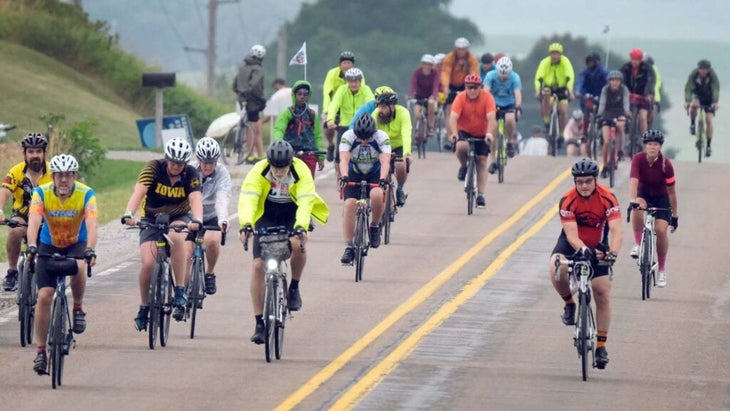
The Register’s Annual Great Bicycle Ride Across Iowa—or RAGBRAI, as it’s known—is the state’s most famous tourist gathering, billed as the “oldest, largest, and longest multi-day bicycle touring event in the world.” More accurately, it’s a seven-day festival on two wheels that crisscrosses open prairies and farm fields for 400-plus miles. Founded in 1973 when a few friends and colleagues at the Des Moines Register got together for a casual tour across the state, it’s since exploded to welcome roughly 30,000 riders. The route is different each time.
This year’s edition is 424 miles long, with 18,737 feet of climbing, the most in its history. That’s right, Iowa is not exactly flat; river valleys and low hills dot the landscape and make for a challenging ride, especially over 400 miles. The registration deadline for weeklong participants has passed, but single-day passes and nonrider wristbands will be available at RAGBRAI merchandise trailers during the event.
This is not a competitive race; everyone is encouraging and more than willing to help each other out. It’s all very Midwest nice, and one of the best ways to slow down and appreciate the scenery. You might be surprised how much beauty there is to be had here.
Where to Stay: Organizers provide registered riders with support vehicles, gear shuttles, and access to home stays and housing. That said, most participants camp, the better option if you want to feel connected to the RAGBRAI community. Temporary campgrounds are set up at schools, county fairgrounds, and city parks, where a convivial atmosphere prevails at night and a definite sense of comradery.
Don’t Miss: Each year RAGBRAI offers an optional century loop during one day of the ride and alternative routes on well-maintained farm roads for gravel bikers. In 2024, the century ride takes place on day six and will be between the southeastern towns of Ottumwa and Mount Pleasant. There are gravel-road options for each day of the event.
July 27-28: Valle De Bravo, Mexico
Not long ago, this tiny, cobblestone-street town on the shores of Lake Avándaro was dubbed the “Hamptons of Mexico City.” It’s an unfair comparison. Yes, both are popular summer destinations for cosmopolitan city folk, but Valle de Bravo is more visually appealing, culturally intriguing, and adventurous than New York’s Hamptons. Also, at 6,000 feet elevation, with peaks soaring above it, this is a legitimate mountain town.
In winter, paragliders from around the world come to take advantage of the valley’s consistent mountain thermals, and visitors flock to the nearby Piedra Herrada Monarch Butterfly Sanctuary, where millions of migrating monarch butterflies congregate. But summer is equally active, with sailing and stand-up paddleboarding on the lake (which is really a reservoir), hiking or horseback riding to waterfalls, and mountain biking the professionally built and maintained trails in the hills.
The colonial town’s centuries-old structures are now home to buzzy bars and cafés. Late July and August is the rainy season in this part of Mexico, but storms tend to roll through in the afternoon and the effect cools temperatures and only contributes to the greenery, so it’s not considered a hindrance. Hike or ride in the morning (when it tends to be sunny), enjoy a long lunch and a siesta, and then head back to one of the paddleboard shops in town later in the day, rent an SUP, and get out on the lake for another few active hours.
Where to Stay: Mubu Hotel Boutique is a five-star property right in the center of town, with a rooftop bar that overlooks Valle De Bravo’s sea of red-tiled roofs (from $180). Just outside town, stay in suspended forest bungalows at Hotel Rodavento, located along the banks of a spring-fed river (from $250). The property has numerous adventure offerings, including a six-station zip line, a climbing wall, and its own mountain-biking trail.
Don’t Miss: Velo de Novia (Bridal Veil Falls) in the neighborhood of Avándaro, an affluent suburb of Valle de Bravo. The two-mile hike to the 115-foot high waterfall is easy, and you can follow it up with a stroll or drive around town to check out some of the multimillion-dollar homes that host the who’s who of Mexico City.
Where to Go in August
August 4-5: Any U.S. National Park

On August 4, to celebrate the anniversary of the Great American Outdoors Act, visitors to all national parks will get in free. The act, which was passed four years ago, is a big deal: in addition to providing $9.5 billion over five years to address a maintenance backlog at the parks, it also permanently authorizes the Land and Water Conservation Fund, the program that pays for land and water acquisitions (and easements) for recreational benefits.
This time of year, two of the more popular parks to visit are Yellowstone and Grand Teton, in Wyoming, so you might want to shift your gaze to some of America’s least visited national parks, which include refreshing water-based options like Isle Royale, in Michigan, and Voyageurs, in Minnesota. Even cool Carlsbad Caverns, 750 feet below the Chihuahuan Desert in southern New Mexico, is a smart way to beat the heat.
Where to Stay: National park campgrounds are an iconic part of the American-outdoors experience. They can be busy and book quickly, but many offer walk-in sites and are uniquely positioned to offer incredible experiences, like waking up in a temperate rainforest (in Olympic, in Washington), near a lobster boat pulling in traps (in Acadia, in Maine), or in the shadow of El Capitan, where Alex Honnold made his historic free-solo ascent (in Yosemite, in California). Plus, posting up for two or more nights allows you to focus on and sync up with the natural rhythms of a park’s wildlife.
Don’t Miss: The two remaining free days at the national parks this year—National Public Lands Day, on September 28, and Veterans Day, on November 11. The Park Service foregoes entrance fees on a half dozen days each year; check out the full list here. Also, for general info and maps, the National Park Service’s app is exceptional. I wouldn’t visit a park without it.
August 10-11: Churchill, Manitoba
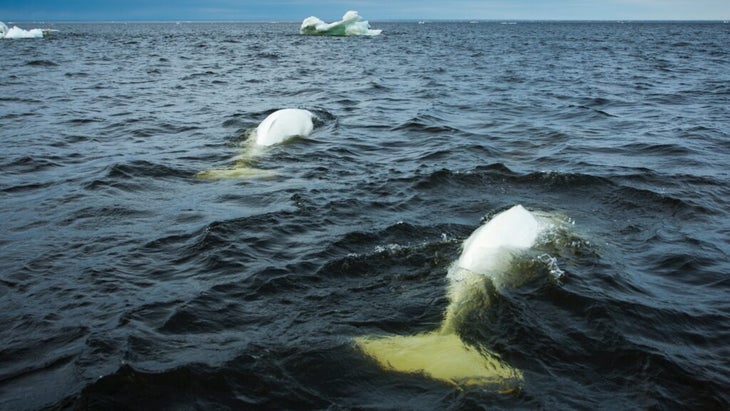
This may be the polar bear capital of the world, but every summer a far more entertaining animal arrives to wow tourists. From June to September, an estimated 3,000 beluga whales migrate into the mouth of the Churchill River, offering one of the best chances on the planet to commune with these incredibly smart and friendly mammals.
These white whales are highly sociable, speaking to one another with loud whistles and unmistakable chirps. Like parrots, they can even imitate other sounds. Their ability to “talk,” combined with their natural curiosity, makes them one of the most compelling species to interact with. Lazy Bear Expeditions offers three-hour kayaking tours to spot them, or join Sea North Tours’ paddleboard trip to see the whales up close.
Getting to this remote town on the Hudson Bay is only possible by small plane or train. On Via Rail it’s a two-day journey from Winnipeg, or hop aboard in Thompson to cut your travel time down to an overnight ride. Once in town, take polar-bear-warning signs seriously. While October and November are considered prime bear-viewing months, they still come right into Churchill in August.
Where to Stay: Most lodging options here veer toward motel-like stays, and the best in-town property is the rustic Lazy Bear Lodge, with a giant stone fireplace and meals made with organic food grown in a greenhouse in town. For more of a high-end package that takes care of lodging, excursions, and food, Churchill Wild has eight-night trips from $11,000 per person.
Don’t Miss: The northern lights. They’re not guaranteed, but with the sun’s solar cycle 25 peaking later this year and next, your chances of witnessing a dazzling celestial event are increased. Churchill is located on the 58th parallel north—the same latitude as southern Alaska and Norway—so you’ll be closer to the action happening in the auroral oval. Also, on this weekend, the sun sets at roughly 9:15 P.M and rises at 5:27 A.M., and only a crescent moon will be hovering in the sky, so if the lights have decided to put on a show, you’ll still have ample darkness to enjoy them.
August 17-18: Refuge Outdoor Festival, Snoqualmie Valley, Washington
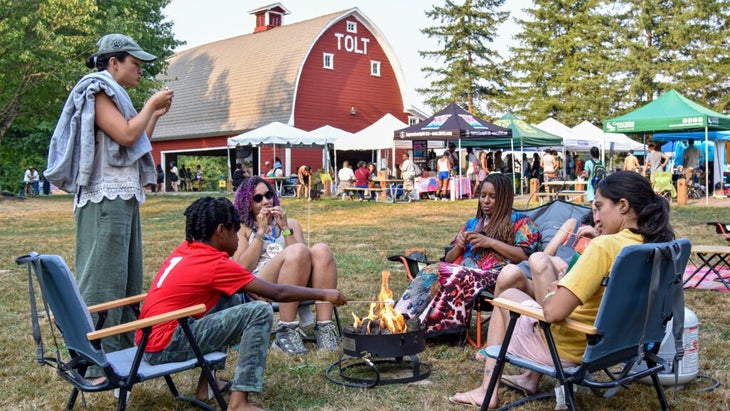
This three-day campout, which begins August 16, is one of a few gatherings entirely devoted to celebrating the diverse outdoor experiences and contributions of the BIPOC community. This year marks seven years since the event first kicked off, and it’s since grown into a full-fledged festival, with DJs, workshops, art, and recreational activities.
You can take morning walks, sign up for sessions on survival skills, and relax with an hour or two of forest bathing. All allies of the BIPOC community are welcome, and specific functions have been created to support LGBTQ+ attendees. Refuge Outdoor Festival happens just 30 miles east of downtown Seattle at the 575-acre Tolt-MacDonald Park and Campground in the town of Carnation, and tickets start at $125 for adults.
Where to Stay: On-site accommodations are the way to go. A camping permit can be had for $20, and REI has partnered with festival organizers to loan out a tent, two cots, chairs, and a table for organizing your stuff for $150. Alternatively, a park yurt with bunk beds for up to six people and an outdoor fire ring runs for $400 for all three nights.
Don’t Miss: The stunning Snoqualmie Valley. Driving up the valley from Carnation will give you a better sense of its impressiveness, and hiking to 270-foot high Snoqualmie Falls offers an eye-opening sense of the eponymous river’s strength. For a more rigorous trek, check out the 9.7-mile Mailbox Peak Trail Loop.
August 24-25: Duke’s OceanFest, Oahu, Hawaii
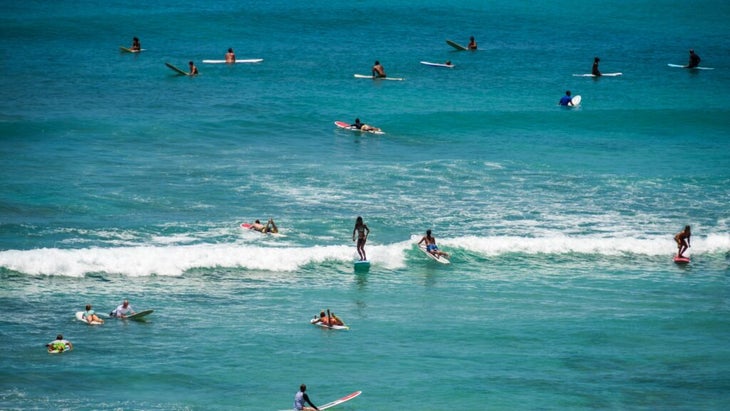
Catch the tail end of this ten-day ocean-sports festival, which celebrates the legacy of the “father of surfing” Duke Kahanamoku. Starting August 17, Waikiki Beach hosts a range of events and numerous competitions in fields you might expect—surfing, outrigger canoeing, beach volleyball—and some you might not, like dog surfing. Some local and international participants train all year for Duke’s, but even if you’re just there to watch, spectating is a thrill and the weather in Hawaii in August is amazing—one of the driest months, with ocean temperatures close to 80 degrees—and passing a few days on these Pacific beaches are going to make you the envy of many.
Where to Stay: If you were coming to Oahu any other weekend, you might find compelling reasons to stay outside the high-rise capital city of Honolulu. Not this time, as most events take place on or near Waikiki. The iconic Royal Hawaiian, with its pink facade, is one of the best-known hotels on this stretch of sand, (from $450), while a newer, hip entry to the scene is The Laylow (from $357), where you’ll be greeted with a gift of flip-flops and poolside shave ice.
Don’t Miss: Hoomaluhia Botanical Garden, where admission is free. Once you’ve had your fill of sun and sand, swing over to the windward (eastern) side of the island for a walk in this 400-acre park at the base of the towering Koolau Range. These lush grounds, home to countless tropical trees and flowers, also offer campsites (from $32 for three days). It all feels like Jurassic Park, only sans dinosaurs.
August 31-September 1: Burning Man, Black Rock Desert, Nevada
Yeah, yeah, the tech-bro burners have turned this once-transcendent festival into a weekend rager for the well-heeled. Or maybe you heard rumors that when last year’s record rains swamped the playa, it left thousands stranded and devolved into a free-for-all scenario. Neither stereotype is accurate. In fact, the majority of attendees banded together in 2023 to help each other out, sharing food, lodging, and car space.
Say what you will about Burning Man—more than three decades later, it’s still a hell of a good time, provided you go with the right mindset. You’re encouraged to let your freak flag fly, a hallmark of the artistic expression that emerges in Black Rock City (the name for the temporary town that springs up during festivities). Purists would say Burning Man is still about experiencing the creativity of the human mind; this year’s theme is “Curioser and Curioser,” a nod to Alice in Wonderland.
Where to Stay: Tickets into Black Rock City cost $575, which doesn’t include a vehicle pass, an extra $175. If you’re just now considering attending, check out the certified resale program, open now, as well as the website for all pricing details. Camping is the only way to stay on the playa, although everyone’s definition of this varies dramatically here, from pup tents pitched next to your car to enormous canvas tents that could be straight out of Dune. An annual City Plan is released each year with the locations of open camping, where you can park your car, and walk-in camping on the wide-open playa, so check it out before arrival. Also, if you’re a first-timer, The Survival Guide is mandatory reading, to understand the vibe and the basic practicalities you need to take into account before any trip there.
Don’t Miss: The Temple of Together, an artist installation created by hundreds that requires weeks of prior efforts. This summer’s temple design will evoke the image of two hands joining, and the structure will span 94 feet and rise 70 feet above the playa.

Ryan Krogh is a writer and editor based in Austin, Texas. This summer he’s heading to Matagordo Bay, on the Gulf Coast, for fly-fishing; North Dakota to visit family; New Mexico to visit friends; Mexico City for some culture; and Iceland for a friend’s 50th birthday party. He will not be at Burning Man, despite his endorsement.



